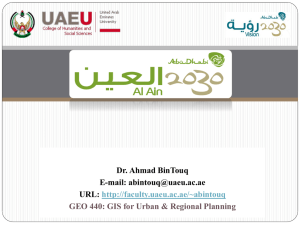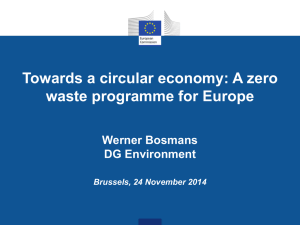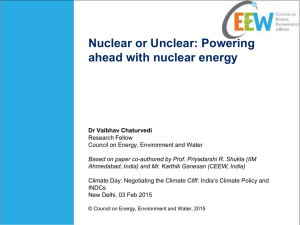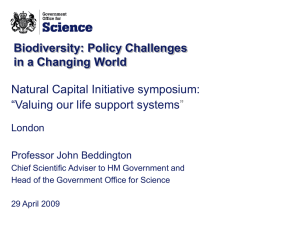The_Energy_Union_-_UK_Position_Non
advertisement
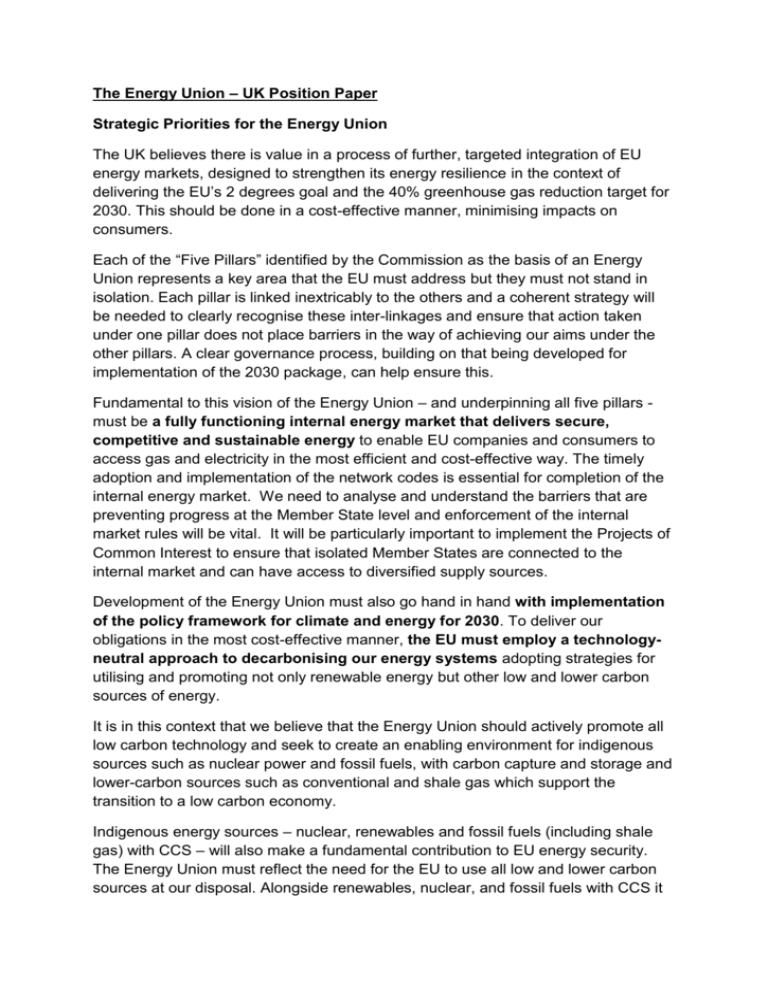
The Energy Union – UK Position Paper Strategic Priorities for the Energy Union The UK believes there is value in a process of further, targeted integration of EU energy markets, designed to strengthen its energy resilience in the context of delivering the EU’s 2 degrees goal and the 40% greenhouse gas reduction target for 2030. This should be done in a cost-effective manner, minimising impacts on consumers. Each of the “Five Pillars” identified by the Commission as the basis of an Energy Union represents a key area that the EU must address but they must not stand in isolation. Each pillar is linked inextricably to the others and a coherent strategy will be needed to clearly recognise these inter-linkages and ensure that action taken under one pillar does not place barriers in the way of achieving our aims under the other pillars. A clear governance process, building on that being developed for implementation of the 2030 package, can help ensure this. Fundamental to this vision of the Energy Union – and underpinning all five pillars must be a fully functioning internal energy market that delivers secure, competitive and sustainable energy to enable EU companies and consumers to access gas and electricity in the most efficient and cost-effective way. The timely adoption and implementation of the network codes is essential for completion of the internal energy market. We need to analyse and understand the barriers that are preventing progress at the Member State level and enforcement of the internal market rules will be vital. It will be particularly important to implement the Projects of Common Interest to ensure that isolated Member States are connected to the internal market and can have access to diversified supply sources. Development of the Energy Union must also go hand in hand with implementation of the policy framework for climate and energy for 2030. To deliver our obligations in the most cost-effective manner, the EU must employ a technologyneutral approach to decarbonising our energy systems adopting strategies for utilising and promoting not only renewable energy but other low and lower carbon sources of energy. It is in this context that we believe that the Energy Union should actively promote all low carbon technology and seek to create an enabling environment for indigenous sources such as nuclear power and fossil fuels, with carbon capture and storage and lower-carbon sources such as conventional and shale gas which support the transition to a low carbon economy. Indigenous energy sources – nuclear, renewables and fossil fuels (including shale gas) with CCS – will also make a fundamental contribution to EU energy security. The Energy Union must reflect the need for the EU to use all low and lower carbon sources at our disposal. Alongside renewables, nuclear, and fossil fuels with CCS it will also need to make a fundamental contribution to decarbonising the energy sector as part of the transition to a low carbon economy. We must also look to strengthen the EU’s energy security through, for example, maximising supply diversity, particularly for those Member States currently reliant on single suppliers, for example through the development of LNG terminals in the South and East, Southern Corridor and Caspian energy, increased reverse flow and exploitation of shale gas. This includes creating an enabling environment for all low and lower carbon forms of generation. The UK considers that these key objectives should sit at the heart of the Energy Union and can, and should, be delivered without the need for the transfer of any further competence for climate and energy issues from Member States; without going beyond the agreed climate and energy policy framework for 2030; and without financing beyond that agreed in the 2014-20 Multiannual Financial Framework. Priorities for the Five Pillars This section sets out UK priorities against each of the five pillars identified by the Commission. Pillar 1 – Promoting energy security including through European solidarity and trust and speaking with one voice The UK considers that it is vital that energy security remains a high priority for the EU. The EU has declining indigenous oil and (conventional) gas resources and is increasingly exposed to international oil and gas markets, where a number of suppliers have demonstrated that they are prepared to use leverage over energy supplies to exert political pressure on the EU. We cannot isolate ourselves from the global market and we are exposed to threats to security of supply. It is therefore important for the EU to be in a position to take action to protect its security of supply, though the principle should be clearly established under the Energy Union that intervention/regulation should only be adopted when clear market failures are identified and costs and benefits have been assessed. Indigenous energy sources – nuclear, fossil fuels (including shale gas) with CCS – will also make a fundamental contribution to EU energy security and de-carbonisation and the Energy Union must reflect the need for the EU to use all low and lower carbon sources at our disposal. Priorities for action under this pillar are: The Commission should prioritise and facilitate a market response to enhancing security of supply in the EU by introducing competition in uncompetitive markets and implementing the Third Energy Package. The Commission should continue to take an active role to ensure that Member States do not take action incompatible with the EU internal market acquis, as was the case with Intergovernmental Agreements (IGAs) related to the proposed Southstream pipeline, with all future IGAs with non-EU parties to be discussed with the Commission ahead of signature. Addressing infrastructure bottlenecks and interconnection needs throughout Europe and better interconnecting markets, taking a holistic view of the most cost-effective means of achieving our energy security objectives. Maximising supply diversity, particularly for those Member States currently reliant on single suppliers, for example through the development of LNG terminals in the South and East, Southern Corridor and Caspian energy, increased reverse flow and exploitation of shale gas. This includes creating an enabling environment for all low and lower carbon forms of generation – including both nuclear and shale energy. Encouraging adequate incentives across the EU for avoiding supply disruption. The Commission has a useful role in helping Member States’ national gas companies renegotiate contracts with external suppliers where requested; this should continue. The Commission is going to examine the possibility of developing voluntary collective gas purchasing. If this is to go ahead, the Commission must ensure it defends the internal market and competition law, including ensuring that short term measures in this area do not impact the long-term development of a functioning internal energy market. To see a more pro-active nuclear policy in the EU, reflecting the requirements in the EURATOM Treaty to “promote” the use of nuclear energy and focussed on security of nuclear fuel supply and financing mechanisms. The Commission bringing forward a comprehensive EU CCS strategy. This should include a Roadmap indicating the measures necessary to advance CCS in the short (to 2020), medium (to 2030) and long term (to 2050) to enable commercial deployment of CCS on the scale that will be needed both for the power and industrial sectors. To manage uncertainty surrounding shale gas exploitation by reaching a clear decision that additional EU legislation is not required to regulate the industry and to focus attention on supporting the growth of the industry by facilitating knowledge transfer between those Member States interested in pursuing exploitation of their shale resources in an environmentally-friendly manner. Optimising the amount of energy, both heat and electricity, produced form residual waste. Energy security should be a key policy priority for the High Representative in her engagement with key supplier countries (ie. US, Norway, North Africa, Middle East, Central Asia) and countries that are key to global energy markets (China and emerging consumers). This work should be supported by a functioning close relationship between a cell in the EEAS and the DG ENER Unit for external affairs, alongside other relevant DGs including DEVCO and TRADE. The Energy Community should continue to be utilised as the primary mechanism for binding neighbourhood countries into the EU’s internal energy market. Pillar 2 - A completed energy market to connect the whole of Europe The UK has been a long-term advocate of completion of the internal market as being fundamental to both improving the EU’s energy security and delivery of a sustainable EU energy system while ensuring competitive energy prices. Whilst progress has been made, the pace of implementation has varied between Member States. Priorities for the Energy Union are: Full implementation of the existing acquis and timely completion of the work on network codes with firm action by the Commission, within its existing competence, to enforce the opening of markets to competition and external sources to deliver a functioning market. Concentrated efforts to drive the Projects of Common Interest forward to enhance interconnection within the EU, focussing particularly on the short list of priority projects, by addressing regulatory barriers and/or market failures and providing political and technical support. Support for regional approaches where there are particular regional challenges or opportunities, or where acting regionally can speed market integration or pilot new approaches on a smaller scale, for example the development of electricity grids or CO2 transport and storage networks in the North Sea. Consideration of how the internal market can be balanced securely to cope with enhanced renewable and distributed generation, including the role of storage, demand side response and smart grids (instead of a focus solely on interconnection). Measures taken by Member States to ensure security of supply, such as the introduction of capacity mechanisms, should aim to minimise distortions to cross-border trading. Pillar 3 - Demand moderation to improve security and keep bills in check Improvements in energy efficiency will make a key contribution to energy security, competitiveness and the achievement of climate objectives. The UK supports action on energy efficiency at the EU level when it can add value to domestic action, for example on energy performance standards and labelling for energy-using products and on addressing financing barriers, but believes that it will be important to avoid over-prescriptive legislation that can constrain domestic policy choices about how best to promote energy efficiency within a national context. It will be important to continue progress on working with industry to deliver innovative technological solutions that offer both low carbon but also real world benefits to consumers. Priorities for the Energy Union are: Avoiding any challenge to the principle that, post 2020, EU energy efficiency targets should be non-binding and not apply at the national level, for example as a result of the 2016 review of the Energy Efficiency Directive and the 2017 review of the Energy Performance of Buildings Directive. Using the forthcoming reviews of energy efficiency legislation to streamline the Directives to minimise duplication and/or conflict between them to ensure they play a supportive role in taking forward the Energy Union and delivery of the EU’s 2030 objectives. Continuing implementation of ambitious and dynamic energy performance standards and labelling for energy-using products. Active ambition for the new CO2 regulations for cars and vans and the extension to trucks. Effective utilisation of existing EU funding schemes, notably European Structural and Investment Funds and the EU Investment Plan, to support investments in energy efficiency, including enhanced technical assistance to ensure a pipeline of good quality and bankable projects. The Commission taking a facilitative role across the EU via the development of funding and support mechanisms that can be used at the regional/city and local level. Pillar 4 - Decarbonising the energy mix and making Europe the global leader in renewables and other low carbon technologies. Agreement of the 2030 package has established the framework for de-carbonising the EU economy to 2030 in line with the cost-effective decarbonisation pathway to 2050. The priority looking ahead will be the development of the necessary legislation and supporting structures to implement the package in a way that is cost-effective and energy-secure and continues the EU’s strong leadership role in the international climate negotiations. With respect to implementation of the 2030 Climate and Energy Framework and a “forward looking climate policy” our priorities are: The EU to continue to demonstrate leadership to generate momentum towards a global climate agreement at the COP in Paris in 2015 that delivers fair and ambitious commitments from all countries, keeping the 2oC target in reach. Continuing recognition of the principle underpinning the 2030 package that it is for Member States to determine the best mix of policies and technologies to deliver de-carbonisation and national climate change targets; recognising that in some areas e.g. product standards EU-level policies are most effective and that in others Member States may choose to work together. The Energy Union must reflect the need for the EU to promote and use all low and lower carbon sources at our disposal. Alongside renewables, nuclear, shale gas and other fossil fuels with CCS will also need to make a fundamental contribution facilitate the transition to a low carbon economy. Introduction of Phase IV EU-ETS legislation and accompanying targeted measures to support sectors genuinely at risk of carbon leakage and introduction of legislation for burden-sharing of targets in the non-traded sector. A robust set of reforms to the EU ETS to tackle the damaging surplus of allowances in the system and to secure a more stable system by tackling the disruptive market impact from the return of backloaded allowances. The UK wants to see the market stability reserve strengthened and implemented as soon as possible. The Commission to consult with Member States and other stakeholders on the implementation of the 2030 GHG target on the basis of draft proposals brought forward by April 2015 at the latest. As envisaged in the OEC Conclusions, the Commission to bring forward proposals to establish a Modernisation Fund, with strict criteria and guidance to ensure that funding is targeted at genuine energy modernisation projects that are demonstrably consistent with attainment of the EU’s 2030 GHG target and longer-term 2050 climate objectives. The Commission must ensure that the legislation to implement provisions allowing lower-income Member States to opt to allocate free allowances to the power sector meets the requirements set out by the European Council. Introduction of effective and transparent light-touch governance structures to track delivery against the EU’s 2030 objectives that do not impose further targets and are created with full consultation with MSs. Development of policy to include LULUCF in the 2030 climate framework must be taken forward in parallel to, and consistent with, development of policy to address GHG emissions from agriculture. The multiple objectives of both LULUCF and agriculture must be recognised in the development of the Energy Union, ensuring coherence with objectives for food security, climate change and growth in the agriculture sector. Member States should retain control over emissions reporting for the agricultural sector. Delivery of the commitment that 20% of the EU Budget should be spent on climate-related activities focussed on cost-effective actions that make a real difference. A strategic approach to the move to a low-carbon power sector, including the implications for support schemes (in particular post-2020) and capacity mechanisms so that any further interventions (at EU or MS level) are coherent and proportionate. Ensuring that development of the Energy Union takes due consideration of requirements for environmental protection and biodiversity, including but not limited to Natura 2000 sites, ensuring a high level of protection for the environment and human health. Recognising and promoting, in particular, the synergies between actions to reduce greenhouse gas emissions and actions to reduce air pollution. Pillar 5 - Leading efforts in research and innovation and green growth. The EU must collectively increase its efforts on low carbon innovation in order to meet our 2030 objectives cost-effectively, make effective progress towards 2050 emissions reduction goals, and improve our energy security. Increasing effort on low carbon innovation can bring significant long term benefits in reduced generation costs and reduced energy demand. It should be a priority for EU MSs to bring down the costs of less mature low carbon energy technologies, particularly those that are likely to be critical to global decarbonisation such as power plants fitted with CCS, and potential breakthrough technologies such as electricity storage. Progress on low carbon innovation is also vital for the future health of Europe’s industrial sector and its contribution to a strong European economy. Our energy intensive industries in particular face real challenges over the long term to remain competitive and contribute to delivering a low carbon economy; the UK welcomes the fact that low carbon innovation in industrial sectors will be eligible for support from the NER400. Maintaining a strong position in innovative clean technologies will continue to present substantial economic opportunities as other major economies take action to decarbonise. Safe and environmentally sound exploration of unconventional hydrocarbons is another area that is crucial for both the EU’s energy security and competitiveness, while maintaining progress towards our decarbonisation targets. Building on the current support under Horizon 2020, more research on best available technologies and methodologies would bring benefits in identifying and mitigating environmental impacts and risks and foster innovative solutions and their dissemination. However, the EU needs to manage its innovation efforts effectively to ensure that we deliver on these goals. In particular, there is a need to effectively target existing funding and align innovation activities with the Strategic Energy Technologies (SET) Plan. Priorities for innovation under an Energy Union are: To ensure that the increased funding available through Horizon 2020 and other agreed sources including the new NER400 is targeted effectively at key technologies in line with the SET plan. Priorities should include renewables technologies, energy storage, CCS and to drive a paradigm shift towards more energy efficiency in the processes of energy intensive industries. To ensure that sufficient support is provided for projects at the pre-commercial stage. While increased activity is needed at all stages of the research and development chain, the biggest gap is currently at the pre-commercial demonstration stage where action at the EU level can bring economies of scale. To accelerate Commission and Member State collaboration and partnership towards implementation of the SET Plan, and to ensure that the plan tackles the following key energy challenges: o facilitating the development of increasingly active consumers; o creating demand focus to address energy efficiency; o facilitating systems optimisation at all levels; o developing a strong portfolio of energy technologies to deliver secure, cost-effective, clean and competitive energy supplies; and o addressing cross-cutting issues such as education, skills and socioeconomics to underpin policy-making and policy delivery.


